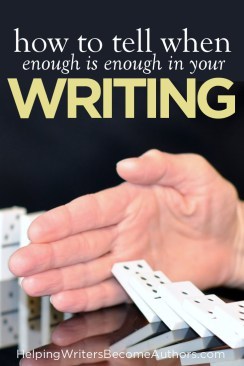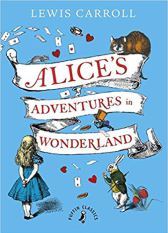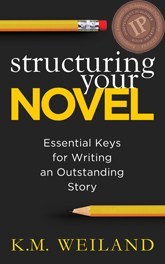When Writing, How Do You Know When Enough Is Enough?
 Last month, I invited you to tell me what topics you’d like me to write about. You flooded my inbox and comments section with suggestions. (I scheduled this as an “easy” post that wouldn’t require much maintenance while I was in the midst of the a big move. When I logged on that first day to over a hundred comments needing to be approved, I was all, Wha? Gah— Ahhh!)
Last month, I invited you to tell me what topics you’d like me to write about. You flooded my inbox and comments section with suggestions. (I scheduled this as an “easy” post that wouldn’t require much maintenance while I was in the midst of the a big move. When I logged on that first day to over a hundred comments needing to be approved, I was all, Wha? Gah— Ahhh!)
I’m psyched by your enthusiasm—and excited to have such a deep well of ideas to draw from for future posts. So, first off—thank you for contributing to the discussion!
And, second, let’s get started…
How Do You Know When Enough Is Enough?
One of the first questions in the queue to catch my eye was Karen Keil’s:
My biggest issues have to do with the term “enough.” How do I know when I have described enough, not described enough, edited enough, not edited enough, dialogued enough, not dialogued enough, been humorous enough… etc.
One of the most difficult things about the art form of writing is how… unquantifiable many aspects are.
What is story but a great big blast of colors and feels right smack in your face?
As a reader or viewer, you just know when something works or it doesn’t. (Lack of artistic credentials has never been—nor ever should be—enough to hold anyone back from passionately loving or hating a piece of art). Explaining the why of any particular technique’s success or lack thereof is much harder. Indeed, even identifying which particular technique is at play sometimes seems like trying to figure out what the elephant is by poking at it in the dark.
Although story is a hugely complicated beast, made up of thousands of tiny individual pieces, it should never look that way. Or at least not when done well. When done well, a story just seems like… a story. It’s cohesive, every piece and every technique flowing effortlessly into the next to create, not a mosaic, but a living photograph.
That’s the beauty of art.
Perhaps not surprisingly, it’s also the very thing that causes huge pain points for the artist.
We must learn to deconstruct the living photograph into the individual pixels that create it. Otherwise, we will never be able to identify what’s gone wrong when one of the colors is incorrect or over-saturated or blacked out.
This is particularly pertinent when it comes to questions of what is “enough” in any aspect of your story.
The reason this is a difficult problem is the very fact that it is so abstract. There are no concrete answers. What might be enough description or dialogue in one section of the story will not be enough in another section. Learning to understand when enough is enough in your story is largely a matter of refining your storytelling instincts to the point where you can just feel whether something is too sparse or too excessive.
So how do you learn to refine those instincts? What that question is really asking is: How do you take your vague, sometimes-hard-to-access feelings about your story and turn them into a conscious understanding based on quantifiable parameters?
Ultimately, that’s what the entire pursuit of story theory and technique has been about for me. You could argue that the entire body of work I’ve created in this blog and my how-to books has been my effort to answer that question. But today, in response to Karen’s question, let’s specifically look at ways you can quantify when you’ve done “enough” in the four sections she’s highlighted.
1. How Much Description Is Enough?
Why not start with the toughest one first, right?
Finding that sweet spot between “too much description” and “not enough description” is a tricky one for many writers. Most of us start out info-dumping descriptive details like a garbage truck the day after Christmas. We want readers to see everything we see: every room of the character’s childhood house, every freckle on the love interest’s nose, every piece of clothing in the protagonist’s warrior ensemble.
But then somewhere along the line, a wise beta reader slaps us with the dictate to “trim the description.” So we overcompensate, looking for that one, right “telling” detail that pops the whole setting without requiring detailed descriptions.
And then… another beta reader tells us, “I can’t get any kind of sense of the setting these characters are supposed to be in.”
Gah. Maddening.
This seesawing between extremes is, however, an important part of honing those storytelling instincts. Learning to find the sweet spot of “enough” description is very much a matter of trial and error.
Last spring, I wrote an entry in the Most Common Writing Mistakes series about “Too Much Description.” In it, I wrote over-the-top examples of what “too much” description looked like. Then I went hunting for examples, from some of my favorite authors, of what the “just right” amount of description looked like. Ironically, many of their excellent descriptions actually ended up being longer than the egregious examples I created.
The lesson here is that “enough” description has nothing to do with word count. It has everything to do with pertinence; with finding the right details; and looking at settings, people, and objects through the strict viewpoint of the narration.
Know exactly what effect you’re trying to achieve in any given passage.
 Is the whole point to introduce the setting? Well then, maybe you can get away with a chapter’s worth of description as Thomas Hardy famously did in
Return of the Native
(or maybe not).
Is the whole point to introduce the setting? Well then, maybe you can get away with a chapter’s worth of description as Thomas Hardy famously did in
Return of the Native
(or maybe not).Is the point to quickly enliven a walk-on character? Then a swift, well-chosen detail will likely suffice.
Is the scene focused on advancing the plot? Then opt for interspersing details throughout the scene, as the characters interact with them.
Study how your favorite authors utilize description. Even go so far as to copy out whole passages of their work. Description is rarely just dumped into a story one huge paragraph at a time. Most of the time, it is a living, breathing part of the story, interacting with every other part, sentence by sentence and even word by word.
2. How Much Editing Is Enough?
Now we take a temporary step back from the nitty-gritty of actual technique to look at the broader topic of how much time we should be spending on the story itself.
To me, the question of “when should I stop editing” shares the same pitfalls as the question of “when should I write ‘the end’?”
 Lewis Carroll said it with appropriate gravity in Alice’s Adventures in Wonderland:
Lewis Carroll said it with appropriate gravity in Alice’s Adventures in Wonderland:
“Begin at the beginning,” the King said, very gravely, “and go on till you come to the end: then stop.”
In short, just as choosing when to write “the end” to your story is not an arbitrary decision, neither is choosing when you stop editing.
You stop editing when the story is finished—when there is nothing more to fix.
That might sound a little blithe. After all, most of us agree with Leonardo da Vinci that:
Art is never finished, only abandoned.
And it’s true. There is always something an author wants to change about a story. We are always growing, always learning—which means the totality of understanding we bring to a story on any given day will always be surpassed by what we have learned on the next. Plus, there’s the little fact that our intent always grows at a slightly faster rate than our ability to execute it.
Still, there are quantifiable ways in which to judge whether or not a story has reached a reasonable level of completion—in both the writing and the editing. For the most part, both approaches overlap.
There are two fundamental questions I ask myself to help me know whether I’m finished with a story or not:
1. Is the Story Structurally Complete?

The only way to know whether a story has reached its end—whether it is a complete whole—is to examine whether or not it is structurally cohesive and complete. When structure is observed, you never have to guess when it’s time to end a story—it just ends itself after the Climactic Moment.
2. Is There Anything Specific Left to Change?
Even after you’ve written/edited your story into a state of structural wholeness, you will very likely still find weaknesses to fix. A structurally sound story doesn’t, by any means, instantly qualify as a good story. You may still find yourself identifying any number of issues—everything from sloppy prose (too much/too little description, anyone?) to sloppy themes to ugly plot holes to ugly scene structure.
Don’t approach your editing like a street brawl: don’t just go in swinging. Have a plan. Consciously evaluate your story and make a list of all the problems you know need fixing. Then fix them. Then consciously re-evaluate your story. Make another list. Fix the problems on the list. And repeat. And repeat. And repeat. Until… there’s nothing left on your list.
Once you’ve got an empty list, you’re done editing.
But what if your list never empties? After all, if there’s no such thing as a perfect novel, there will always be more imperfections to address.
Two things.
First off, differentiate between things you think might be a problem with the story (aka, heretofore unsubstantiated doubts) and things you know are problems. Having doubts about a story is not the same as identifying specific problems that need to be addressed.
Second, know when to cut loose. Maybe you’ll never reach the very end of that list of edits. But there will come a time when you get close enough that it counts. For this, I like deadlines. I tell myself I have five years, from outline to final edit, to get a story right. If it’s not right by then, it’s time to cut loose and move on.
3. How Much Dialogue Is Enough?
I’d like to say there’s no such thing as too much dialogue—because personally I adore dialogue. But the more accurate approach to the proper amount of dialogue is different, if just as simple.
Dialogue becomes too much at the exact moment it isn’t pertinent to the story.
Often, authors will “write their way into dialogue” in order to figure out a scene or a conversation as they go. Dialogue is exceptionally characterizing, so feeling your way through a dialogue section may also be a (great) way of learning about who your characters really are, from the inside out.
This is is all fine and well in the first draft. But meandering conversations that only gradually find their way to a point—or, just as faulty, conversations that exist just for the sake of conversation—are always going to be problematic.
Just as you should examine every single sentence of narrative to make sure each one contributes in its own right, so too you should also examine every line of dialogue. If it contributes—either by advancing the plot, developing the character, or revealing important information—then it belongs. If not, it’s too much.
One of an author’s most important (and, in some ways, most difficult) jobs is being able to identify the purpose of each word in the narrative. Once you learn to do this, it becomes easy to identify which ones belong and which ones do not.
4. How Much Humor Is Enough?
My response to humor is kinda like my response to dialogue: no such thing as too much, right?
Except that, too, is facetious. Really, what I’m responding to is the element of entertainment both dialogue and humor bring to story. I do dearly love to be entertained.
If your humor is entertaining (i.e., it works), then you’ve already aced its primary reason for existing.
Beyond that, humor shares other qualifiers with dialogue in that it must be pertinent to the story. Funny can’t exist just to be funny. It must offer resonance and contribute to cohesion.
But do you need humor?
I honestly can’t think of a single story that can’t benefit from a meaningful inclusion of humor at appropriate moments. But humor, perhaps more than any other element of story, must flow. You can’t force it. It must arise from the situations and characters you’ve already created.
Whenever you have the opportunity to include humor, go for it. But if those opportunities aren’t arising, don’t worry. However entertaining humor may be, it’s not a prerequisite to an amazing story. There’s many a great story out there that cracks nary a smile.
***
Know what effect you’re trying to achieve in your writing and stick to that with confidence. The “enough” you’re seeking will always find its balance when you’re able to realize your intended effect. If, by the story’s end, you’ve succeeded in creating that effect, then your story is “enough.” If not, it’s time to go back and figure out whether you’re missing the mark because you’ve included “too much” or “too little” of any of the above elements.
Wordplayers, tell me your opinions! Do you struggle with knowing when enough is enough in certain areas of your writing? Tell me in the comments!
http://www.podtrac.com/pts/redirect.mp3/kmweiland.com/podcast/enough-is-enough.mp3
Click the “Play” button to Listen to Audio Version (or subscribe to the Helping Writers Become Authors podcast in iTunes).
The post When Writing, How Do You Know When Enough Is Enough? appeared first on Helping Writers Become Authors.



